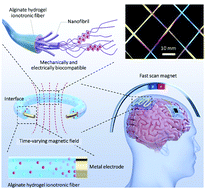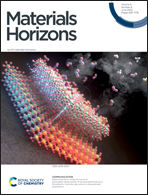Mechanically and electrically biocompatible hydrogel ionotronic fibers for fabricating structurally stable implants and enabling noncontact physioelectrical modulation†
Abstract
Narrowing the mechanical and electrical mismatch between tissue and implantable microelectronics is essential for reducing immune responses and modulating physioelectrical signals. Nevertheless, the design of such implantable microelectronics remains a challenge due to the limited availability of suitable materials. Here, the fabrication of an electrically and mechanically biocompatible alginate hydrogel ionotronic fiber (AHIF) is reported, which is constructed by combing ionic chelation-assisted wet-spinning and mechanical training. The synergistic effects of these two processes allow the alginate to form a highly-oriented nanofibril and molecular network, with a hierarchical structure highly similar to that of natural fibers. These favourable structural features endow AHIF with tissue-mimicking mechanical characteristics, such as self-stiffening and soft tissue-like mechanical properties. In addition, tissue-like chemical components, i.e., biomacromolecules, Ca2+ ions, and water, endow AHIF with properties including biocompatibility and tissue-matching conductivity. These advantages bring light to the application of AHIFs in electrically-conductive implantable devices. As a prototype, an AHIF is designed to perform physioelectrical modulation through noncontact electromagnetic induction. Through experimental and machine learning optimizations, physioelectrical-like signals generated by the AHIF are used to identify the geometry and tension state of the implanted device in the body. Such an intelligent AHIF system has promising application prospects in bioelectronics, IntelliSense, and human–machine interactions.



 Please wait while we load your content...
Please wait while we load your content...